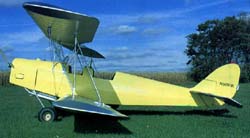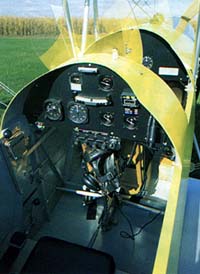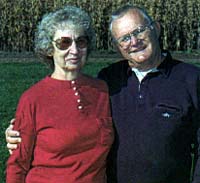A
Perennial Homebuilder Strikes Again
…
Ken Flaglor’s R-80
Tiger Moth
by Mary Jones
(photos by Ken
Lichtenberg)
 If you’ve been hanging around
EAA gatherings for any length of time, you’ll
quickly recognize Ken Flaglor’s name. Ken loves to
build airplanes, and while he’s “threatening” that
his latest creation, a Fisher Flying Products
R-80 Tiger Moth, is his last, it’s not likely
many of his friends really believe that. For
certain, his wife Barbara doesn’t. If you’ve been hanging around
EAA gatherings for any length of time, you’ll
quickly recognize Ken Flaglor’s name. Ken loves to
build airplanes, and while he’s “threatening” that
his latest creation, a Fisher Flying Products
R-80 Tiger Moth, is his last, it’s not likely
many of his friends really believe that. For
certain, his wife Barbara doesn’t.
An active modeler as
well, Ken doesn’t limit his building to only
full-size aircraft. Until the Tiger Moth,
though, he has built his aircraft strictly from
plans — or designed them himself. He introduced
the Flaglor Scooter to EAAers at the 1967 EAA
Convention in Rockford and subsequently described
it in the January 1968 issue of
SPORT AVIATION. With an empty weight of 390
lbs., it was named the “Outstanding Ultra-Light”
of the 1967 air show. Power for the Scooter was a
36 hp converted VW engine. He converted a Fleet
16-B into a glider tow plane, calling it the High
Tow, in addition to building a replica of the Gee
Bee Model Y Senior Sportster, a Sonerai II and an
Ultra-Pup and completing a friend’s Emeraude. In
other words, Ken is a builder’s builder.
He’s also an engine
tinkerer, so it’s not surprising that he chose a
Subaru auto engine, an EA-81, to power his Tiger
Moth. Years ago, Ken experimented with two-cycle
engines, putting two Cushman 18 hp golf cart
engines on a Cherokee II glider, and he first
tried a Cushman engine on the Scooter before going
to the VW.
Ken says when he saw
the Tiger Moth at the Convention a few years back
“it was a grabber right away.” “Certain airplanes
are like that; when you see it you want it.” He
immediately asked about the availability of plans
and was told the airplane was only available as a
kit. That stalled him a while since he really
prefers working from plans, but eventually he bit
the bullet and bought the kit. It arrived in
August of 1995; this past June the completed
aircraft passed FAA inspection on the 26th and Ken
took it for its first spin on the 27th.
Building from a kit
was, of course, a new experience for Ken, but not
necessarily one he’d repeat. “I saved a lot of
time by not having to make all the fittings —
that’s the biggest advantage of building from a
kit — but I’m one of those guys who’d rather do my
own thing. At the same time, though, I don’t
believe in changing somebody else’s design, so I
built the kit according to the manual. In the end,
I’m probably better off having built this airplane
from a kit because if I had designed it, it
probably would have weighed a lot more.
I would have added more to the structure, but
these folks come from the ultralight community so
they design lighter than what some of us old
timers do. Some of our airplanes have more macho
integrity than they necessarily need.”
 The empty weight
of Ken’s Tiger Moth is 673 lbs., which compares to
590 lbs. for the factory prototype. Ken says he
can easily account for most of the weight
difference. “My Subaru engine weighs 210 lbs.; no
doubt that’s significantly more than the Norton
Rotary engine in the prototype. Plus, I have a
muffler, which adds another 5 lbs. I added an
extra wing tank and with all its plumbing that
becomes fairly heavy. When I ordered my radiator,
I forget to specify an aluminum radiator so the
guy sent me a copper radiator and that’s about 5
lbs. more, so it all adds up quickly.” The empty weight
of Ken’s Tiger Moth is 673 lbs., which compares to
590 lbs. for the factory prototype. Ken says he
can easily account for most of the weight
difference. “My Subaru engine weighs 210 lbs.; no
doubt that’s significantly more than the Norton
Rotary engine in the prototype. Plus, I have a
muffler, which adds another 5 lbs. I added an
extra wing tank and with all its plumbing that
becomes fairly heavy. When I ordered my radiator,
I forget to specify an aluminum radiator so the
guy sent me a copper radiator and that’s about 5
lbs. more, so it all adds up quickly.”
Converting the
Subaru
Ken bought an “off the
boat” Subaru engine; i.e., one of the 30,000 mile
engines that come off automobiles in Japan and
then are shipped to the U.S. for secondary use. He
paid $495.00 for the engine from an importer in
Cleveland, Ohio. With the exhaust system,
muffler, radiator and redrive, which came from Don
Parham at RFI, Ken says he has about $2,600.00
invested in the total engine installation. “The
redrive was the most expensive part; it cost about
$1,600. That was the only thing I really didn’t
want to tackle in the conversion. Other things
I could do myself.” His radiator is from a
diesel Volkswagen Rabbit. He also added an oil
cooler and now is very pleased with all his engine
temperatures. “The oil temperature especially came
down from ridiculously high to perfect with the
radiator and oil cooler.”
Ken started flying the
aircraft/engine combination with a propeller off a
65 hp Continental but was dissatisfied with the
climb performance. He figures he was getting about
80 hp from the engine at 4400 rpm. “The EA-81’s
rated at 72 hp at 4800 rpm in a car, and Reiner
Hoffman of Stratus gets about 100 hp from his
improved EA-81 turning it at 5500 rpm, so I was
hoping to get mine to turn at least 4800, but no
matter how we reworked the prop, the fastest
I could get it was 4400. I originally wanted
to use a GSC ground adjustable prop, but it
wouldn’t fit a conventional hub. While at Oshkosh
this year, though, I learned there’s now an
adapter available that I could put on my Subaru so
I could use the GSC propeller. Since then, I’ve
gotten the adaptor and have put the GSC prop on
and it’s a completely different airplane to fly.
It climbs at 500 fpm solo and about 350-400 fpm
with a passenger on board. It cruises nicely at 70
mph at 4200 rpm with 25 inches of manifold
pressure. 80-85 mph is about as fast as it’ll go,
but remember, this engine is stock; I’ve done
nothing to increase its horsepower rating.” The
prop is 72 inches in length and Ken’s best guess
is that it’s pitched at about 40 inches. “It’s
difficult to get an accurate measurement off this
blade,” he says.
As mentioned earlier,
Ken’s engine weighs 210 lbs. all up. That includes
the reduction drive, muffler, exhaust, radiator,
coolant and mounting brackets. “I think it’s
important people know what the engine installation
weighs in total, not just the engine itself. Some
folks think they can do a conversion for about 180
lbs., and they’re kidding themselves. In the end,
the weight of this conversion is pretty equivalent
to an 85 hp Continental.”
Still, Ken thinks the
auto engine conversions are a great way for folks
to inexpensively power their aircraft. “I think
auto conversion’s are the only salvation for the
little guy who wants to build an airplane.
We’re going to run out of 65 Continentals
and Lycomings and ground power units. If you have
a slow, light plane you don’t have to have
something hot with lots of power. Overall,
this engine runs superb. I also think the
Volkswagen engine is still one of the biggest
sleepers around. I’ve flown three VW-powered
airplanes and they performed well, too.”
Altogether, Ken figures he has about $14,000
invested in his Tiger Moth.
One of the few
modifications Ken did make to the airframe turned
out to be very popular with the Fisher factory
folks as well. Although Ken had sent them a
photo of his completed aircraft, no one at the
factory had seen his airplane “in person” until
this year’s Convention. Once they saw it, they
were quite impressed, especially with his idea to
make the center section gas tank removable. “It’s
certainly more practical if the tank ever needs
repairs,” says Ken. Probably the voice of
experience speaking.
 In all of his
building experiences, Ken has often wondered just
exactly how much weight covering and painting an
aircraft adds. With his Tiger Moth, he decided to
find out. After building the wings, Ken weighed
one of the top wings with all its fittings, but
without the ailerons. It weighed 22 lbs. bare.
After covering with Poly-Fiber, taping, one brush
coat and two sprays coats of Poly-Fiber fill, two
cross coats of silver and two cross coats of
color, the wing weighed 27 lbs. “It was kind of
interesting to find out; sometimes you’ll hear
people say, ‘it’s so heavy with paint it won’t
fly,’ but now we have kind of a benchmark for how
much weight it really adds.” All in all, Ken’s
thoroughly enjoying flying his Tiger Moth. When
his wife asked him a few months ago which was his
favorite airplane to fly, the Emeraude, the
Ultra-Pup or the Tiger Moth, Ken says he picked
the Tiger Moth. “I really enjoy the open cockpit,
low and slow flying. That’s the way I like to
fly.” It’s now wonder, then, that he knew he had
to have a Tiger Moth the first time he saw
it. In all of his
building experiences, Ken has often wondered just
exactly how much weight covering and painting an
aircraft adds. With his Tiger Moth, he decided to
find out. After building the wings, Ken weighed
one of the top wings with all its fittings, but
without the ailerons. It weighed 22 lbs. bare.
After covering with Poly-Fiber, taping, one brush
coat and two sprays coats of Poly-Fiber fill, two
cross coats of silver and two cross coats of
color, the wing weighed 27 lbs. “It was kind of
interesting to find out; sometimes you’ll hear
people say, ‘it’s so heavy with paint it won’t
fly,’ but now we have kind of a benchmark for how
much weight it really adds.” All in all, Ken’s
thoroughly enjoying flying his Tiger Moth. When
his wife asked him a few months ago which was his
favorite airplane to fly, the Emeraude, the
Ultra-Pup or the Tiger Moth, Ken says he picked
the Tiger Moth. “I really enjoy the open cockpit,
low and slow flying. That’s the way I like to
fly.” It’s now wonder, then, that he knew he had
to have a Tiger Moth the first time he saw
it.
|